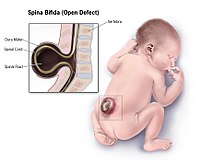
Photo from wikipedia
OBJECTIVE We assessed the frequency and type of associated congenital anomalies encountered with fetal tethered spinal cord (TSC) determined prenatally. METHOD A retrospective review was conducted based on the associated… Click to show full abstract
OBJECTIVE We assessed the frequency and type of associated congenital anomalies encountered with fetal tethered spinal cord (TSC) determined prenatally. METHOD A retrospective review was conducted based on the associated fetal abnormalities following diagnosis of low-lying fetal conus medullaris during the prenatal ultrasound. RESULTS Of the 26 fetuses with low-lying conus medullaris, four were solitary TSC and 22 had TSC combined with associated congenital malformations, including four cases with spina bifida occulta, four cases with spina bifida aperta, one case with severe hydrocephalus, and 13 cases with multisystem congenital malformations. Among all the 13 cases with combined multisystem congenital malformations, four cases had vertebral defects, anal anomalies, cardiac defects, trachea-esophageal fistula, renal anomalies, and limb anomalies (VACTERL) syndrome, two cases had combined kidney development abnormalities, one case had cloacal exstrophy (OEIS syndrome), and six cases had chromosomal abnormalities (one case of chromosome 7q deletion, two cases of trisomy 13 syndrome, one case of trisomy 18 syndrome, one case of trisomy 9 syndrome, and one case of chromosome 4p deletion). CONCLUSIONS Low-lying conus medullaris found during prenatal ultrasound examination were often associated with neural tube malformations or multi-systemic complex developmental malformations. The frequency of chromosomal abnormalities was 23.1%.
Journal Title: Fetal and pediatric pathology
Year Published: 2023
Link to full text (if available)
Share on Social Media: Sign Up to like & get
recommendations!